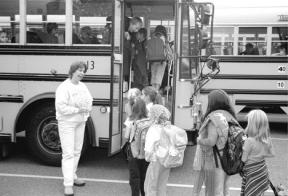Dollars will be rolling down the road next week in South Whidbey school buses. Each student who rides during Bus Ridership Week, Oct. 6-10 will mean money to the district’s 2003-04 transportation fund.
The state counts bus ridership for one week each fall to determine the amount of transportation funding to the district for the year.
Margaret Evans, district transportation director hopes to see 1,300 students riding buses next week.
“That’s 200 up from last year,” she said.
The annual count of school bus ridership is more important than ever during tough financial times for the state’s schools and the district’s fund balance shortage. Any shortfall in transportation funding comes out of the general fund.
“We could fund the transportation department’s operating budget 100 percent with better bus ridership,” Evans said.
Budgeted this year for transportation is $734,000; the transportation vehicle fund is $245,000 and may only be used to purchase new vehicles.
During previous years, the amount funded to South Whidbey, based on the count covers about 70 percent of the transportation department’s operating budget, including wages.
The remainder has to come from the district’s general fund.
In 2000-01 ridership was 1,319 students during the ridership count week.
For an effective count, students need to ride a minimum of three days during next week on morning routes.
Evans is encouraging parents to support school bus travel next week because district transportation is vital for after school activities as well.
The district has 24 regular routes with and nine special special education routes. The district provides transportation for Shared Schooling Cooperative students and Langley Christian School based on available space.Transportation services to Langley Christian School is a courtesy because it is located across the road from the public primary and intermediate schools.
The state’s formula allocating funds is complicated. It is based on where the students live, the radius mile from their home school and the number of times they ride.
The radius system is less effective in rural areas because it doesn’t take into account bodies of water, twisting roads and forests.


